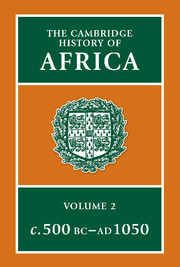Book contents
- Frontmatter
- Introduction
- 1 The legacy of prehistory: an essay on the background to the individuality of African cultures
- 2 North Africa in the period of Phoenician and Greek colonization, c. 800 to 323 BC
- 3 North Africa in the Hellenistic and Roman periods, 323 BC to AD 305
- 4 The Nilotic Sudan and Ethiopia, c. 660 bc to c.ad 600
- 5 Trans-Saharan contacts and the Iron Age in West Africa
- 6 The emergence of Bantu Africa
- 7 The Christian period in Mediterranean Africa, c.ad 200 to 700
- 8 The Arab conquest and the rise of Islam in North Africa
- 9 Christian Nubia
- 10 The Fatimid revolution (861–973) and its aftermath in North Africa
- 11 The Sahara and the Sudan from the Arab conquest of the Maghrib to the rise of the Almoravids
- Bibliographical essays
- Bibliography
- Index
- Plate Sections
- Plate Sections
- Plate Sections
- References
11 - The Sahara and the Sudan from the Arab conquest of the Maghrib to the rise of the Almoravids
Published online by Cambridge University Press: 28 March 2008
- Frontmatter
- Introduction
- 1 The legacy of prehistory: an essay on the background to the individuality of African cultures
- 2 North Africa in the period of Phoenician and Greek colonization, c. 800 to 323 BC
- 3 North Africa in the Hellenistic and Roman periods, 323 BC to AD 305
- 4 The Nilotic Sudan and Ethiopia, c. 660 bc to c.ad 600
- 5 Trans-Saharan contacts and the Iron Age in West Africa
- 6 The emergence of Bantu Africa
- 7 The Christian period in Mediterranean Africa, c.ad 200 to 700
- 8 The Arab conquest and the rise of Islam in North Africa
- 9 Christian Nubia
- 10 The Fatimid revolution (861–973) and its aftermath in North Africa
- 11 The Sahara and the Sudan from the Arab conquest of the Maghrib to the rise of the Almoravids
- Bibliographical essays
- Bibliography
- Index
- Plate Sections
- Plate Sections
- Plate Sections
- References
Summary
THE TRADE OF THE SAHARA
The Saharan trade and the introduction of Islam were the two principal external factors in the history of West Africa before 1500. Through trade and Islam, Africa south of the Sahara became irreversibly linked to the wider world. In this process the second half of the first millennium AD, or the centuries following the Arab conquest of North Africa, may be viewed as the formative period. The Arab invasion set in motion a transformation of North Africa and its society which extended into the Sahara and eventually reached the Sudan.
Oral traditions in the Sahara and the Sudan seek direct association with ‘Uqba b. Nāfi‘, the general who led the Arab troops to the Maghrib al-Aqsā, i.e. to the ‘Farthest Maghrib’ or ‘Farthest West’, the territory now known as Morocco, to reach the Sea of Darkness (the Atlantic) in the west, and the Sea of Sand (the Sahara) in the south. According to some traditions, ‘Uqba continued his raids as far as the frontiers of the Sudan. Fulani traditions describe ‘Uqba as the leader of their migration from the (north-) east. The arabized Kunta, a Saharan tribe of saints and scholars, trace their pedigree back to ‘Uqba, claiming that he himself had conquered Biru (i.e. Walata) and Takrur. The fourteenth-century Ibn Abī Zar‘ says that the Banū Wārith, a Ṣanhāja tribe in the neighbourhood of Adrar, were converted to Islam by ‘Uqba b. Nāfi‘.
Keywords
- Type
- Chapter
- Information
- The Cambridge History of Africa , pp. 637 - 684Publisher: Cambridge University PressPrint publication year: 1979
References
- 4
- Cited by



